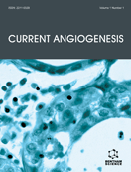Abstract
Neoangiogenesis plays an essential role in colorectal carcinogenesis. Using murine models of colorectal cancer and confocal laser endomicroscopy (CLE), the aim of this study was to optimize methodology and develop a robust scoring system to distinguish vascular characteristics of neoplastic colonic tissue from normal colon. Tumors were induced in mice using standard protocols with either azoxymethane (AOM) or azoxymethane/dextran sulfate sodium (AOM/DSS). In vivo imaging studies were performed with colonoscopy to identify visible lesions followed by CLE with either fluorescein sodium to assess microarchitecture or fluorescein-isothiocyanate linked to dextran (FITC-D) to visualize blood vessels. Qualitative and quantitative morphometric measures detected by CLE were developed that included a 10-point scoring system to characterize abnormal blood vessel features. Tumor vessels differed significantly from normal vessels in loss of vessel co-planarity, vessel dilation, sprouting, irregular vessel pattern, and dye extravasation from vessels (each parameter p<0.0001). An overall score of 4 or more was significantly associated with tumor vessels compared to normal colonic blood vessels (p<0.0001). Fourier analysis of blood vessel patterns also showed striking differences between neoplastic and normal blood vessels. We propose a simple 10-point scoring system to distinguish neoplastic from normal vessels based on CLE. This methodology and scoring system could provide quantitative measures of neoplastic angiogenesis to advance our understanding of tumor biology and cancer risk assessment and monitor responses to therapy.
Keywords: Confocal laser endomicroscopy, colonic carcinogenesis, murine colonoscopy, neoangiogenesis, tumor vascularity.
 15
15

